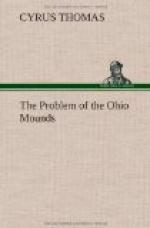Stone graves have been found in Washington County, Md. [Footnote: Smithsonian Report for 1882 (1884), p. 797.] History informs us that there were two Shawnee settlements in this region, one in the adjoining county of Maryland (Allegany), and another in the neighborhood of Winchester, Va. [Footnote: C. C. Royce in American Antiquarian, vol. 3, 1881, p. 186. Virginia State Papers, 1. p. 63.]
Mr. W. M. Taylor [Footnote: Smithsonian Report for 1877, p. 307. Mentions only known instance of mound with Delaware Village.] mentions some stone graves of the type under consideration as found on the Mahoning River, in Pennsylvania. An important item in this connection is that these graves were in a mound. He describes the mound as 35 feet in diameter and 5 feet high, having on one side a projection 35 feet long of the same height as the mound. Near by a cache was discovered containing twenty one iron implements, such as axes, hatchets, tomahawks, hoes, and wedges. He adds the significant statement that near the mound once stood the Indian (Delaware) village of Kush-kush-kee.
Graves of the same type have been discovered in Lee County, Va. [Footnote: Eleventh Report of the Peabody Museum, 1878, p. 208.] Others have been found in a mound on the Tennessee side, near the southern boundary of Scott County, Va. Allusion has already been made to the occasional presence of the Shawnees in this region. In the map of North America by John Senex, Chaonanon villages are indicated in this particular section.
The presence of these graves in any part of Ohio can easily be accounted for on the theory advanced, by the well-known fact that both Shawnees and Delawares were located at various points in the region, and during the wars in which they were engaged were moving about from place to place; but the mention of a few coincidences may not be out of place.
In the American Antiquarian for July, 1881, is the description of one of these cists found in a mound in the eastern part of Montgomery County. Mr. Royce, in the article already referred to, states that there was a Shawnee village 3 miles north of Xenia, in the adjoining county, on Mad River, which flows into the Miami a short distance above the location of the mound.
Stone graves have been found in great numbers at various points along the Ohio from Portsmouth to Ripley, a region known to have been occupied at various times by the Shawnees.
Similar graves have been discovered in Ashland County. [Footnote: Smithsonian Report for 1877, pp. 261-267.] These, as will be seen by reference to the same report (page 504), are precisely in the locality of the former Delaware villages.
The evidence is deemed sufficient to show that the Shawnees and Delawares were accustomed to bury in stone graves of the type under consideration, and to indicate that the graves found south of the Ohio are to be attributed to the former tribe and those north to both tribes.




